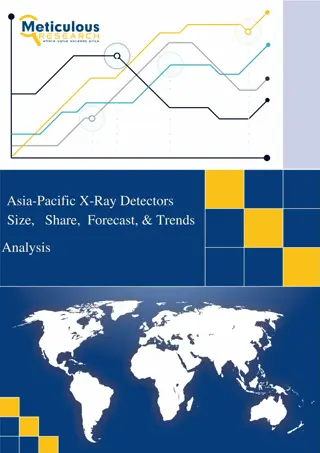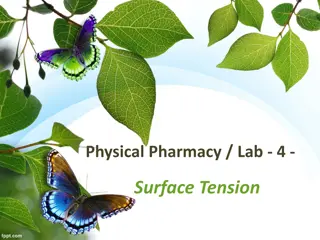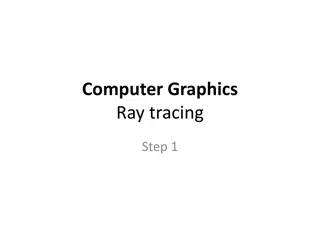Hidden Surface Removal in Computer Graphics
In computer graphics, the hidden-surface problem refers to identifying and removing surfaces that are not visible in a given view to create a realistic screen image. Different methods like Depth Buffer (Z-Buffer) and Scan-Line are used to address this issue by determining the closest visible surface and rendering it onto the screen. Professor Dr. A. H. M. Kamal from JKKNIU explains the Object-Space and Image-Space approaches for hidden-surface removal in the context of computer graphics.
Download Presentation

Please find below an Image/Link to download the presentation.
The content on the website is provided AS IS for your information and personal use only. It may not be sold, licensed, or shared on other websites without obtaining consent from the author. Download presentation by click this link. If you encounter any issues during the download, it is possible that the publisher has removed the file from their server.
E N D
Presentation Transcript
CSE 403: Computer Graphics HIDDEN SURFACE: When we view a picture containing non-transparent objects and surfaces, then we cannot see those objects from view which are behind from objects closer to eye. We must remove these hidden surfaces to get a realistic screen image. The identification and removal of these surfaces is called Hidden-surface problem. When we want to display a 3D object on a 2D screen, we need to identify those parts of a screen that are visible from a chosen viewing position. Front non-transparent object Front transparent object Prof. Dr. A. H. M. Kamal, CSE, JKKNIU
CSE 403: Computer Graphics HIDDEN SURFACE: There are two approaches for removing hidden surface problems Object-Space method: It is implemented in physical coordinate system. Image-space method: Image-space method is implemented in screen coordinate system. Front non-transparent object Front transparent object Prof. Dr. A. H. M. Kamal, CSE, JKKNIU
CSE 403: Computer Graphics HIDDEN SURFACE: Depth Buffer (Z-Buffer) Method of hidden surface removal: This method is developed by Cutmull. It is an image-space approach. The basic idea is to test the Z-depth of each surface to determine the closest (visible) surface. In this method each surface is processed separately one pixel position at a time across the surface. The depth values for a pixel are compared and the closest (smallest z) surface determines the color to be displayed in the frame buffer. Prof. Dr. A. H. M. Kamal, CSE, JKKNIU
CSE 403: Computer Graphics HIDDEN SURFACE: Depth Buffer (Z-Buffer) Method of hidden surface removal: Depth buffer is used to store depth values for (x, y) position, as surfaces are processed (0 depth 1). The frame buffer is used to store the intensity value of color value at each position (x, y). The z-coordinates are usually normalized to the range [0, 1]. The 0 value for z-coordinate indicates back clipping pane and 1 value for z-coordinates indicates front clipping pane. Prof. Dr. A. H. M. Kamal, CSE, JKKNIU
CSE 403: Computer Graphics HIDDEN SURFACE: Depth Buffer (Z-Buffer) Method of hidden surface removal: Figure 1: Example 1 Algorithm Step-1 Set the buffer values Depthbuffer (x, y) = 0 Framebuffer (x, y) = background color Step-2 Process each polygon (One at a time) For each projected (x, y) pixel position of a polygon, calculate depth z. If z > depthbuffer (x, y) Compute surface color, set depthbuffer (x, y) = z, framebuffer (x, y) = surfacecolor (x, y) Figure 2: Example 2 Advantages Disadvantages It is easy to implement. It processes one object at a time. It requires large memory. It is time consuming process. Prof. Dr. A. H. M. Kamal, CSE, JKKNIU
CSE 403: Computer Graphics HIDDEN SURFACE: Scan-Line Method of hidden surface removal: It is an image-space method to identify visible surface. This method has a depth information for only single scan-line. In order to require one scan-line of depth values, we must group and process all polygons intersecting a given scan-line at the same time before processing the next scan-line. Two important tables, edge table and polygon table, are maintained for this. Prof. Dr. A. H. M. Kamal, CSE, JKKNIU
CSE 403: Computer Graphics HIDDEN SURFACE: Area-Subdivision Method of hidden surface removal: Divide the total viewing area into smaller and smaller rectangles until each small area is the projection of part of a single visible surface or no surface at all. Surrounding surface One that completely encloses the area. Overlapping surface One that is partly inside and partly outside the area. Inside surface One that is completely inside the area. Outside surface One that is completely outside the area. Prof. Dr. A. H. M. Kamal, CSE, JKKNIU
CSE 403: Computer Graphics HIDDEN SURFACE: Area-Subdivision Method of hidden surface removal: Divide the total viewing area into smaller and smaller rectangles until each small area is the projection of part of a single visible surface or no surface at all. No further subdivisions of a specified area are needed if one of the following conditions is true All surfaces are outside surfaces with respect to the area. Only one inside, overlapping or surrounding surface is in the area. A surrounding surface obscures all other surfaces within the area boundaries. Prof. Dr. A. H. M. Kamal, CSE, JKKNIU
CSE 403: Computer Graphics HIDDEN SURFACE: Depth Sorting Method of hidden surface removal: Depth sorting method uses both image space and object-space operations. The depth- sorting method performs two basic functions First, the surfaces are sorted in order of decreasing depth. Second, the surfaces are scan-converted in order, starting with the surface of greatest depth. The scan conversion of the polygon surfaces is performed in image space. This method for solving the hidden-surface problem is often referred to as the painter's algorithm. Prof. Dr. A. H. M. Kamal, CSE, JKKNIU
CSE 403: Computer Graphics RAY TRACING: Prof. Dr. A. H. M. Kamal, CSE, JKKNIU
CSE 403: Computer Graphics Ray Traced Image RAY TRACING: Prof. Dr. A. H. M. Kamal, CSE, JKKNIU
CSE 403: Computer Graphics Ray Tracing Model RAY TRACING: Prof. Dr. A. H. M. Kamal, CSE, JKKNIU
CSE 403: Computer Graphics Ray Tracing Model RAY TRACING: Prof. Dr. A. H. M. Kamal, CSE, JKKNIU
CSE 403: Computer Graphics Ray Tracing Model RAY TRACING: Prof. Dr. A. H. M. Kamal, CSE, JKKNIU























